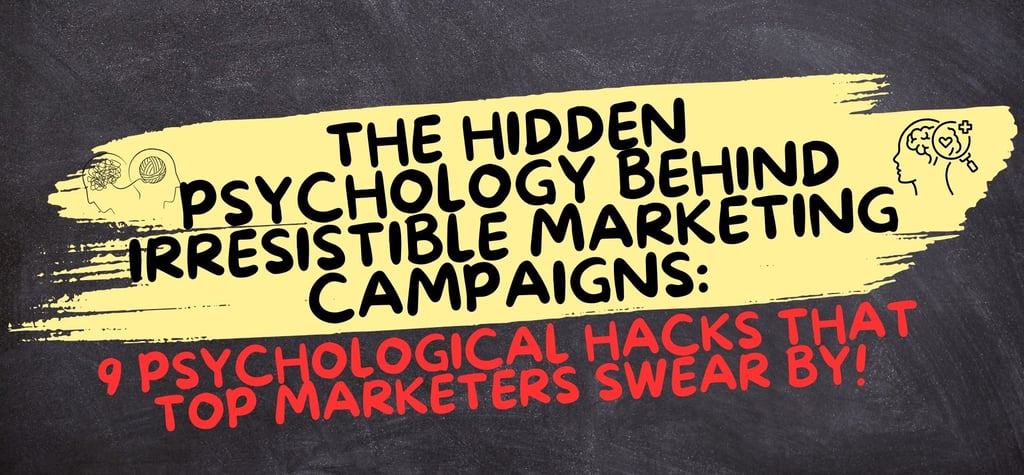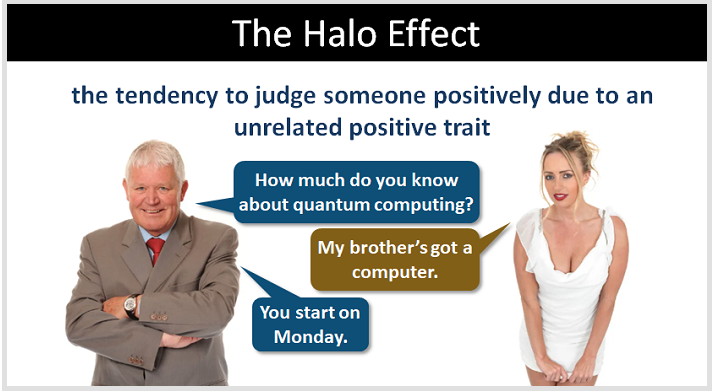The Hidden Psychology Behind Irresistible Marketing Campaigns: 9 Psychological Hacks That Top Marketers Swear By!


In the world of marketing, success isn’t just about creativity or big budgets.
It’s about understanding people - their behaviors, emotions, and decision-making processes. That’s where psychology comes in.
By tapping into these nine mind-blowing psychological concepts, you can elevate your campaigns and connect with your audience on a deeper level.
Here’s how you can use psychology to turn casual viewers into loyal customers:
1. Halo Effect
Definition: People’s overall impression of a person, product, or brand influences their perception of specific traits or qualities.
Key Idea: Positive associations with a brand or individual can lead to favorable judgments about unrelated aspects.
👉 How to use it: Build a strong first impression with top-notch visuals, professional branding, or celebrity endorsements. Your audience will associate that quality with your products or services.
2. Loss Aversion
Definition: People are more motivated by the fear of losing something than the prospect of gaining something of equal value.
Key Idea:
-The emotional pain of loss is stronger than the pleasure of gain.
-Highlighting what a customer might lose if they don’t act can be more effective than emphasizing potential benefits.
👉 How to use it: Emphasize what your audience might miss out on. Use phrases like “Don’t miss this opportunity” or “Only 2 days left!” to drive urgency.
3. Social Proof
Definition: People are more likely to trust and adopt a product or service if they see others using and enjoying it.
Key Idea:
-Testimonials, reviews, and user-generated content act as social proof.
-People tend to follow the crowd, especially when uncertain.
👉 How to use it: Highlight testimonials, customer reviews, and success stories. Show the number of satisfied clients or users to build trust.
4. Confirmation Bias
Definition: People tend to seek out information that confirms their existing beliefs or attitudes.
Key Idea: Customers are more likely to resonate with messaging that aligns with their values or preconceived notions.
👉 How to use it: Craft messages that align with your audience’s values or pain points. Personalization goes a long way in confirming, “Yes, this is exactly what I need.”
5. Scarcity Effect
Definition: When something is perceived as limited or rare, people are more motivated to obtain it.
Key Idea:
-Fear of missing out (FOMO) drives action.
-Scarcity increases perceived value.
👉 How to use it: Introduce limited-time offers, exclusive deals, or countdown timers. “Only 5 left in stock” triggers FOMO (fear of missing out).
6. Anchoring Effect
Definition: People rely heavily on the first piece of information they receive when making decisions.
Key Idea: Initial information serves as a reference point for evaluating other options.
👉 How to use it: Position your high-ticket offer first. When you present a more affordable option afterward, it feels like a steal in comparison.
7. Goal Gradient Effect
Definition: People are more motivated to complete a task as they perceive themselves getting closer to the goal.
Key Idea: Small rewards or visible progress can increase motivation to finish.
👉 How to use it: Use progress bars, loyalty rewards programs, or incremental goals to show customers how close they are to a reward. “You’re 80% to your next discount!” works like magic.
8. Mere-Exposure Effect
Definition: People tend to prefer things they are familiar with.
Key Idea:
-Repeated exposure increases comfort and trust.
-Familiarity can breed preference, even if it’s subconscious
👉 How to use it: Invest in retargeting ads and consistent branding. The more your audience sees your name and logo, the more comfortable they’ll feel with your brand.
9. Authority Bias
Definition: People are more likely to trust and follow the advice of those in positions of authority.
Key Idea:
-Expertise or credentials enhance credibility.
-Endorsements from authoritative figures can drive trust and conversions.s.
👉 How to use it: Showcase certifications, awards, and expert endorsements. Highlight partnerships with well-known brands or influencers in your niche.
Why These Concepts Work
Psychology is at the core of every decision your audience makes.
When you understand their motivations, fears, and behaviors, you don’t just sell a product - you create an emotional connection. That connection leads to trust, loyalty, and growth for your business.
Takeaways:
Human Psychology Drives Decisions: Understanding the way people think and behave can guide marketers to craft compelling campaigns.
Use Emotion to Motivate Action: Concepts like loss aversion and scarcity leverage emotional triggers to encourage quick decision-making.
Trust and Familiarity Build Loyalty: Social proof, authority bias, and mere exposure create a sense of reliability and credibility.
Perception Shapes Reality: Halo effect and anchoring show how initial impressions and comparisons can significantly influence judgment.
So, the next time you plan a campaign, ask yourself:
Which of these concepts can I use to make my message more powerful and memorable?
🔔 Follow for More: Don't miss out on future articles packed with practical tips and inspiring ideas.
Visit my website Kamaleonte Marketing.
Subscribe to my newsletter AI Sapiens.
Stay informed, stay adaptable, and keep thriving


